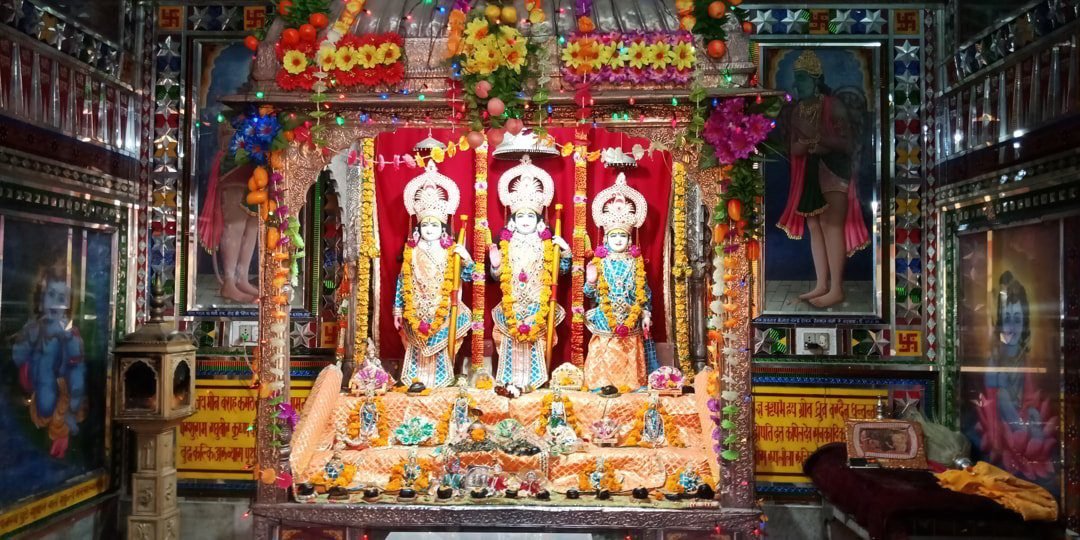Acharyapeeth Raivasa Dham was established in 1570 AD by Agradevacharya Maharaj, the main disciple of Shri Krishnadas Payohari Maharaj, the founder of Galtapeeth. Agradevacharya Maharaj has been accepted by the people of the religious world as a great poet, preacher and innovator of the Rasik tradition in Rambhakti. Apradevacharya Maharaj is revered as the original source of eleven Dwaracharya Peeths out of the thirty-six Dwaracharya Peethas of Ramanand Sampradaya. The didactic horoscopes were created by him. He created Ashtyam Padavali for the Rasik seekers and published the independent guru tradition of Ramanand Sampradaya in the form of dialogues between devotees and elders. Even today, Raivasamath is worshiped at the north gate of Jagannathpuri. About a third of the places that have emerged from the tradition of the Ramanand sect are Moolpeeth Revasapeeth. Agradevacharya ji was a contemporary saint of Tulsidas ji, the author of the Ramayana, Tulsidas ji, sitting in Raivasapeeth Shrijankinath temple, said “Shri Janakinath Sahay Karen, jab kon bigad kare nar tero (जानकी नाथ सहाय करें जब कौन बिगाड़ करे नर तेरो) “. Impressed by the practice of Apradevacharya Amer Naresh Maharaj Mansingh became the first foot-dependent and Emperor Akbar also came to Raiwasapeeth after being impressed by his sadhana.
The temple is open every day from 7:00 a.m. until 12.00 a.m. m. and 3.00 P.M. until 9.00 p.m.
Ramdhun is heard for 24 hours in Raivasa Dham: Ramnavami has a very special meaning for Raivasa Peeth. Swami Raghavacharya Vedanti is the seventeenth Acharya. Ramdhun is heard here 24 hours a day. Tulsidasji, who has written Ramcharitmanas, has come here. Ramayana lessons last 24 hours in Raivasa, the main headquarters of the Ramanand sect. Here Lord Shri Ram is seated with Janaki, Lakshman and Hanumanji. The Jankinath Mahabhishek takes place in Ramnavami. 56 Bhog is also offered. In the 13th century, the melody of Ram Bhakti in Rajasthan began with Sri Jagad Guru Ramanandacharya Maharaj. In his disciple tradition, Shri Krishnadas Payohari established the Galta Peeth in Jaipur and the Raivasa Peeth in Sikar. In the Bhakti movement, the main Ram Bhakti centers in Rajasthan were Galta Peeth and Raivasa.
Besides Hindi, Bhaktmal has been written in many languages, including Sanskrit, Urdu, and English.
Shri Nabhaji, the great 16th century poet and author of the seeker Bhaktamal, described Shri Agradevacharya ji as Guru. As a result, by the grace of Guru’s grace, in the form of birth, by the grace of Shri Agradevacharya ji and Shri Kilhdevacharya ji, he obtained netjyoti. Remaining immersed in the mental service of Shri Agradevacharya ji in the garden of Raivasapeeth, resting at the feet of the Guru, he changed the boat of his devotee caught in the storm by changing the direction of the storm with his fan and prayed to Guru Maharaja to stay. submerged. in mental service and safe rest for the devotee. He also expressed the solution to the relief of suffering in front of Guru Maharaj. Knowing that this cosmic sadhana has reached a high level, Agradevacharya ji was very pleased and ordered you to make garlands with the characters of the devotees to date. Hearing the characters of that devotee, people should cross the ocean of the universe. This Bhaktamal was composed before Samvat 1769 AD. Even today, Bhaktmal has been written in many languages like Hindi, Sanskrit, Urdu, English, etc. In the characters of Bhaktamal, Nabhaji has written verses with the devotees from all over India and the abundant devotees from Rajasthan. All of Rajasthan, along with Raivasapeeth, is proud to receive the creation of Bhaktmal from Nabhaji Maharaj. In the Acharya tradition of Shri Agradevacharya Peeth Raivasa, after 16 Acharyas, Dr. Swami Raghavacharya Vedanti, as the 17th Acharya, is consecrating the religious form of Peeth. In the religious activities of the peeth, the food area with the worship of God, the monolithic Bhagavannam Sankirtana, the Parayan of the uninterrupted Ramcharitmanas, the operation of the Veda Vidyalaya for the preservation of Eastern science, the Sanskrit school for the advancement of Sanskrit . Panchagavya language and drug production through the barn for non-dependent cows. In order to make the cow self-sufficient, arrangements are being made to provide free food, accommodation and study to the students.


0 Comments